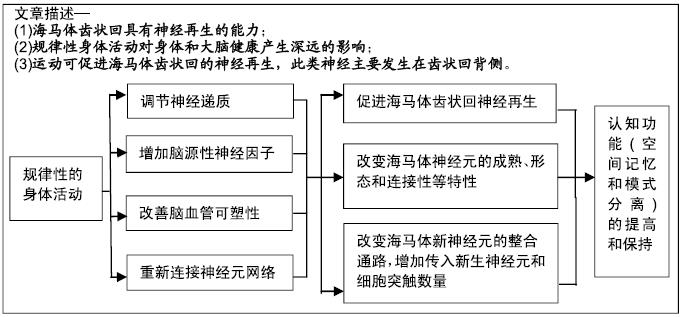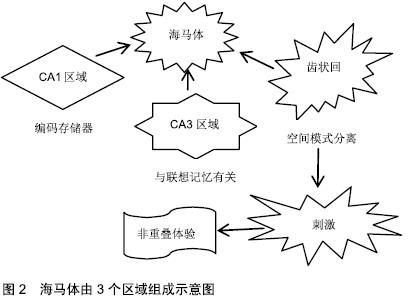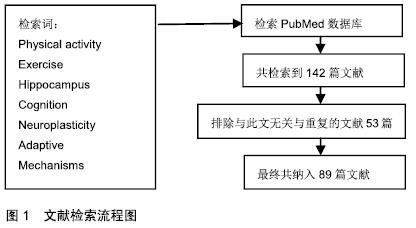[1] VOSS MW, SOTO C, YOO S, et al.Exercise and Hippocampal Memory Systems.Trends Cogn Sci. 2019;23(4):318-333.
[2] BAPTISTA P, ANDRADE JP. Adult Hippocampal Neurogenesis: Regulation and Possible Functional and Clinical Correlates.Front Neuroanat. 2018;12:44.
[3] COOPER C, MOON HY, VAN PRAAG H. On the Run for Hippocampal Plasticity.Cold Spring.Harb Perspect Med.2018;8(4).
[4] ERIKSSON PS, PERFILIEVA E, BJÖRK-ERIKSSON T, et al. Neurogenesis in the adult human hippocampus. Nat Med.1998;4(11): 1313-1317.
[5] AUGUSTE KI, CHANG EF, GUTIERREZ AJ, et al. Human hippocampal neurogenesis drops sharply in children to undetectable levels in adults. Nature.2018;555(7696):377-381.
[6] KNOTH R, SINGEC I, DITTER M, et al. Murine features of neurogenesis in the human hippocampus across the lifespan from 0 to 100 years.PLoS One.2010;5(1):e8809.
[7] BOLDRINI M, FULMORE CA, TARTT AN, et al. Human hippocampal neurogenesis persists throughout aging. Cell Stem Cell.2018;22(4): 589-599.
[8] ROY NS, WANG S, JIANG L, et al. In vitro neurogenesis by progenitor cells isolated from the adult human hippocampus.Nat Med.2000;6(3): 271-277.
[9] SPALDING KL, BERGMANN O, ALKASS K, et al. Dynamics of hippocampal neurogenesis in adult humans. Cell.2013;153(6): 1219-1227.
[10] AMREIN I, ISLER K, Lipp HP.Comparing adult hippocampal neurogenesis in mammalian species and orders: influence of chronological age and life history stage.Eur J Neurosci.2011;34(6): 978-987.
[11] BERGMANN O, SPALDING KL, FRISÉN J. Adult Neurogenesis in Humans. Cold Spring Harb Perspect Biol. 2015;7(7):a018994.
[12] WEST MJ, COLEMAN PD, FLOOD DG, et al.Differences in the pattern of hippocampal neuronal loss in normal ageing and Alzheimer’s disease. Lancet.1994;344(8925):769-772.
[13] SIMIĆ G, KOSTOVIĆ I, WINBLAD B, et al.Volume and number of neurons of the human hippocampal formation in normal aging and Alzheimer’s disease.J Comp Neurol.1997;379(4):482-494.
[14] RIEDEL G, MICHEAU J, LAM AG, et al. Reversible neural inactivation reveals hippocampal participation in several memory processes.Nat Neurosci.1999;2(10):898-905.
[15] ERICKSON KI, VOSS MW, PRAKASH RS, et al. Exercise training increases size of hippocampus and improves memory. Proc Natl Acad Sci U S A.2011;108(7):3017-3022.
[16] ERICKSON KI, LECKIE RL, WEINSTEIN AM.Physical activity, fitness, and gray matter volume. Neurobiol Aging. 2014;35 Suppl 2:S20-28.
[17] VOSS MW, VIVAR C, KRAMER AF, et al.Bridging animal and human models of exercise-induced brain plasticity. Bridging animal and human models of exercise-induced brain plasticity.Trends Cogn Sci. 2013; 17(10):525-544.
[18] WHITEMAN AS, YOUNG DE, BUDSON AE, et al. Entorhinal volume, aerobic fitness, and recognition memory in healthy young adults: A voxel-based morphometry study.Neuroimage.2016;126:229-238.
[19] NAKAZAWA K, MCHUGH TJ, WILSON MA, et al. NMDA receptors, place cells and hippocampal spatial memory. Nat Rev Neurosci.2004; 5(5): 361-372.
[20] NAKAZAWA K, SUN LD, QUIRK MC, et al. Hippocampal CA3 NMDA receptors are crucial for memory acquisition of one-time experience. Neuron.2003;38(2):305-315.
[21] KESNER RP, ROLLS ET.A computational theory of hippocampal function, and tests of the theory: New developments.Neurosci Biobehav Rev. 2015;48:92-147.
[22] BOLIJN S, LUCASSEN PJ. How the Body Talks to the Brain; Peripheral Mediators of Physical Activity-Induced Proliferation in the Adult Hippocampus.Brain Plasticity.2015;1(1):5-27.
[23] BONAGUIDI MA, WHEELER MA, SHAPIRO JS, et al.In vivo clonal analysis reveals self-renewing and multipotent adult neural stem cell characteristics.Cell.2011;145(7):1142-1155.
[24] PATTEN AR, YAU SY, FONTAINE CJ, et al.The benefits of exercise on structural and functional plasticity in the rodent hippocampus of different disease models.Brain Plast.2015;1(1):97-127.
[25] GRÉGOIRE CA, BONENFANT D, LE NGUYEN A, et al.Untangling the influences ofvoluntary running, environmental complexity, social housing and stress on adult hippocampal neurogenesis.PLoS One. 2014;9(1): e86237.
[26] VAN PRAAG H, SHUBERT T, ZHAO C, et al.Exercise enhances learning and hippocampal neurogenesis in aged mice.J Neurosci. 2005;25(38): 8680-8685.
[27] CREER DJ, ROMBERG C, SAKSIDA LM, et al.Running enhances spatial pattern separation in mice. Proc Natl Acad Sci U S A.2010; 107(5): 2367-2372.
[28] VIVAR C, PETERSON BD, VAN PRAAG H, et al. Running rewires the neuronal network of adult-born dentate granule cells.Neuroimage. 2016;131:29-41.
[29] CLARK PJ, KOHMAN RA, MILLER DS, et al.Genetic influences on exercise-induced adult hippocampal neurogenesis across 12 divergent mouse strains.Genes Brain Behav.2011;10(3):345-353.
[30] MOSER MB, MOSER EI, FORREST E, et al.Spatial learning with a minislab in the dorsal hippocampus. Proc Natl Acad Sci U S A.1995; 92(21): 9697-9701.
[31] KJELSTRUP KG, TUVNES FA, STEFFENACH HA, et al. Reduced fear expression after lesions of the ventral hippocampus.Proc Natl Acad Sci U S A.2002;99(16):10825-10830.
[32] SAHAY A, SCOBIE KN, HILL AS, et al. Increasing adult hippocampal neurogenesis is sufficient to improve pattern separation. Nature.2011; 472(7344):466-470.
[33] AIMONE JB, DENG W, GAGE FH.Resolving new memories: A critical look at the dentate gyrus, adult neurogenesis, and pattern separation. Neuron.2011;70(4):589-596.
[34] KODALI M, MEGAHED T, MISHRA V, et al.Voluntary running exercise-mediated enhanced neurogenesis does not obliterate retrograde spatial memory.J Neurosci.2016;36(31):8112-8122.
[35] FARMER J, ZHAO X, VAN PRAAG H, et al. Effects of voluntary exercise on synaptic plasticity and gene expression in the dentate gyrus of adult male Sprague-Dawley rats in vivo.Neuroscience. 2004;124(1):71-79.
[36] ZHAO C, JOU J, WOLFF LJ, et al.Spine morphogenesis in newborn granule cells is differentially regulated in the outer and middle molecular layers.J Comp Neurol.2014;522(12):2756-2766.
[37] STEIB K, SCHÄFFNER I, JAGASIA R, et al.Mitochondria modify exercise-induced development of stem cell-derived neurons in the adultbrain.J Neurosci.2014;34(19):6624-6633.
[38] PIATTI VC, DAVIES-SALA MG, ESPÓSITO MS, et al.The timing for neuronal maturation in the adult hippocampus is modulated by local network activity.J Neurosci.2011;31(21):7715-7728.
[39] KNIERIM JJ. From the GPS to HM:Place cells, grid cells, and memory. Hippocampus.2015;25(6):719-725.
[40] DILLINGHAM CM, FRIZZATI A, NELSON AJ, et al. How do mammillary body inputs contribute to anterior thalamic function? Neurosci Biobehav Rev.2015;54:108-119.
[41] GE S, GOH EL,SAILOR KA, et al.GABA regulates synaptic integration of newly generated neurons in the adult brain.Nature.2006;439(7076): 589-593.
[42] BLISS TV, COLLINGRIDGE GL. A synaptic model of memory: Long-term potentiation in the hippocampus. Nature.1993;361(6407):31-39.
[43] FARMER J, ZHAO X, VAN PRAAG H, et al. Effects of voluntary exercise on synaptic plasticity and gene expression in the dentate gyrus of adult male Sprague–Dawley rats in vivo.Neuroscience.2004;124(1):71-79.
[44] KHEIRBEK MA, TANNENHOLZ L, HEN R.NR2B-dependent plasticity of adult-born granule cells is necessary for context discrimination.J Neurosci.2012;32(25):8696-8702.
[45] TANG YP, WANG H, FENG R, et al. Differential effects of enrichment on learning and memory function in NR2B transgenic mice. Neuropharmacology.2001;41(6):779-790.
[46] SCHMIDT-HIEBER C, JONAS P, BISCHOFBERGER J. Enhanced synaptic plasticity in newly generated granule cells of the adult hippocampus. Nature.2004;429(6988):184-187.
[47] BLAND BH, ODDIE SD. Theta band oscillation and synchrony in the hippocampal formation and associated structures:the case for its role in sensorimotor integration.Behav Brain Res.2001;127(1-2):119-136.
[48] ABRAHAM WC, MASON-PARKER SE, BEAR MF, et al. Heterosynaptic metaplasticity in the hippocampus in vivo: A BCM-like modifiable threshold for LTP.Proc Natl Acad Sci U S A. 2001;98(19): 10924-10929.
[49] HILL LE, DROSTE SK, NUTT DJ, et al. Voluntary exercise alters GABAA receptor subunit and glutamic acid decarboxylase-67 gene expression in the rat forebrain. J Psychopharmacol. 2010;24(5): 745-756.
[50] SCHOENFELD TJ, RADA P, PIERUZZINI PR, et al.Physical exercise prevents stress-induced activation of granule neurons and enhances local inhibitory mechanisms in the dentate gyrus.J Neurosci. 2013; 33(18): 7770-7777.
[51] BAKKER A, KRAUSS GL, ALBERT MS, et al. Reduction of hippocampal hyperactivity improves cognition in amnestic mild cognitive impairment. Neuron.2012;74(3):467-474.
[52] DISHMAN RK. Brain monoamines, exercise, and behavioral stress: Animal models. Med Sci Sports Exerc.1997;29(1):63-74.
[53] TANTIMONACO M, CECI R, SABATINI S, et al. Physical activity and the endocannabinoid system: An overview.Cell Mol Life Sci.2014; 71(14): 2681-2698.
[54] KLEMPIN F, BEIS D, MOSIENKO V, et al. Serotonin is required for exercise-induced adult hippocampal neurogenesis.J Neurosci.2013; 33(19):8270-8275.
[55] KONDO M, NAKAMURA Y, ISHIDA Y, et al. The 5-HT3 receptor is essential for exercise-induced hippocampal neurogenesis and antidepressant effects.Mol Psychiatry.2015;20(11):1428-1437.
[56] CASSILHAS RC, LEE KS, FERNANDES J, et al. Spatial memory is improved by aerobic and resistance exercise through divergent molecular mechanisms.Neuroscience.2012;202:309-317.
[57] BABAEI P, DAMIRCHI A, MEHDIPOOR M, et al.Long term habitual exercise is associated with lower resting level of serum BDNF. Neurosci Lett. 2014;566:304-308.
[58] ERICKSON KI, PRAKASH RS, VOSS MW, et al.Brain-derived neurotrophic factor is associated with age-related decline in hippocampal volume.J Neurosci.2010;30(15):5368-5375.
[59] VAYNMAN SS, YING Z, YIN D, et al. Exercise differentially regulates synaptic proteins associated to the function of BDNF.Brain Res.2006; 1070(1):124-130.
[60] VAYNMAN S, YING Z, GOMEZ-PINILLA F. Hippocampal BDNF mediates the efficacy of exercise on synaptic plasticity and cognition. Eur J Neurosci.2004;20(10):2580-2590.
[61] LI Y, LUIKART BW, BIRNBAUM S, et al. TrkB regulates hippocampal neurogenesis and governs sensitivity to anti-depressive treatment. Neuron.2008;59(3):399-412.
[62] VIVAR C, POTTER MC, CHOI J, et al.Monosynaptic inputs to new neurons in the dentate gyrus. Nat Commun. 2012;3:1107.
[63] SULTAN S, LI L, MOSS J, et al.Synaptic integration of adult-born hippocampal neurons is locally controlled by astrocytes.Neuron.2015; 88(5):957-972.
[64] MIKLIC S, JURIC DM, CARMAN-KRZAN M. Differences in the regulation of BDNF and NGF synthesis in cultured neonatal rat astrocytes.Int J Dev Neurosci.2004;22(3):119-130.
[65] SAUR L, BAPTISTA PP, DE SENNA PN, et al. Physical exercise increases GFAP expression and induces morphological changes in hippocampal astrocytes.Brain Struct Funct.2014;219(1):293-302.
[66] FAHIMI A, BAKTIR MA, MOGHADAM S, et al. Physical exercise induces structural alterations in the hippocampal astrocytes: Exploring the role of BDNF-TrkB signaling.Brain Struct Funct. 2017;222(4): 1797-1808.
[67] MOON HY, KIM SH, YANG YR, et al. Macrophage migration inhibitory factor mediates the antidepressant actions of voluntary exercise.Proc Natl Acad Sci U S A.2012;109(32):13094-13099.
[68] GEBARA E, SULTAN S, KOCHER-BRAISSANT J, et al. Adult hippocampal neurogenesis inversely correlates with microglia in conditions of voluntary running and aging.Front Neurosci.2013;7:145.
[69] SPEISMAN RB, KUMAR A, RANI A, et al.Daily exercise improves memory, stimulates hippocampal neurogenesis and modulates immune and neuroimmune cytokines in aging rats.Brain Behav Immun. 2013;28: 25-43.
[70] EGAN MF, KOJIMA M, CALLICOTT JH, et al. The BDNF val66met polymorphism affects activity-dependent secretion of BDNF and human memory and hippocampal function.Cell.2003;112(2):257-269.
[71] BROWN BM, BOURGEAT P, PEIFFER JJ, et al. Influence of BDNF Val66Met on the relationship between physical activity and brain volume. Neurology.2014;83(15):1345-1352.
[72] IERACI A, MADAIO AI, MALLEI A, et al.Brain-derived neurotrophic factor Val66Met human polymorphism impairs the beneficial exercise- induced neurobiological changes in mice.Neuropsychopharmacology. 2016;41(13):3070-3079.
[73] GOMEZ-PINILLA F, ZHUANG Y, FENG J, et al.Exercise impacts brain-derived neurotrophic factor plasticity by engaging mechanisms of epigenetic regulation.Eur J Neurosci.2011;33(3):383-390.
[74] SLEIMAN SF, HENRY J, AL-HADDAD R, et al.Exercise promotes the expression of brain derived neurotrophic factor (BDNF) through the action of the ketone body β-hydroxybutyrate. Elife.2016;5. pii: e15092.
[75] NISHIJIMA T, OKAMOTO M, MATSUI T, et al.Hippocampal functional hyperemia mediated by NMDA receptor/NO signaling in rats during mild exercise.J Appl Physiol (1985).2012;112(1):197-203.
[76] DELP MD, ARMSTRONG RB, GODFREY DA, et al. Exercise increases blood flow to locomotor, vestibular, cardiorespiratory and visual regions of the brain in miniature swine.J Physiol. 2001;533 (Pt 3):849-859.
[77] Osborne PG. Hippocampal and striatal blood flow during behavior in rats: Chronic laser Doppler flowmetry study.Physiol Behav.1997; 61(4):485-492.
[78] NISHIJIMA T, SOYA H.Evidence of functional hyperemia in the rat hippocampus during mild treadmill running. Neurosci Res.2006; 54(3):186-191.
[79] MURRELL CJ, COTTER JD, THOMAS KN, et al.Cerebral blood flow and cerebrovascular reactivity at rest and during sub-maximal exercise: Effect of age and 12-week exercise training.Age (Dordr). 2013;35(3): 905-920.
[80] PEREIRA AC, HUDDLESTON DE, BRICKMAN AM, et al. An in vivo correlate of exercise-induced neurogenesis in the adult dentate gyrus. Proc Natl Acad Sci U S A.2007;104(13):5638-5643.
[81] VIBOOLVORAKUL S, PATUMRAJ S.Exercise training could improve age-related changes in cerebral blood flow and capillary vascularity through the upregulation of VEGF and eNOS.Biomed Res Int. 2014; 2014:230791.
[82] LICHT T, ROTHE G, KREISEL T, et al. VEGF preconditioning leads to stem cell remodeling and attenuates age-related decay of adult hippocampal neurogenesis.Proc Natl Acad Sci U S A. 2016;113(48): E7828-E7836.
[83] LICHT T, GOSHEN I, AVITAL A, et al. Reversible modulations of neuronal plasticity by VEGF.Proc Natl Acad Sci U S A.2011;108(12): 5081-5086.
[84] FABEL K, FABEL K, TAM B, et al.VEGF is necessary for exercise-induced adult hippocampal neurogenesis.Eur J Neurosci. 2003;18(10): 2803-2812.
[85] LISTER JP, BARNES CA.Neurobiological changes in the hippocampus during normative aging. Arch Neurol.2009; 66(7): 829-833.
[86] RENDEIRO C, RHODES JS.A new perspective of the hippocampus in the origin of exercise-brain interactions.Brain Struct Funct.2018;223(6): 2527-2545.
[87] GUERRIERI D, VAN PRAAG H. Exercise-mimetic AICAR transiently benefits brain function. Oncotarget. 2015;6(21):18293-18313.
[88] WOODS NI, VAAGA CE, CHATZI C, et al. Preferential targeting of lateral entorhinal inputs onto newly integrated granule cells.J Neurosci. 2018; 38(26):5843-5853.
[89] LEAL SL, YASSA MA.Integrating new findings and examining clinical applications of pattern separation.Nat Neurosci.2018;21(2):163-173.
|



